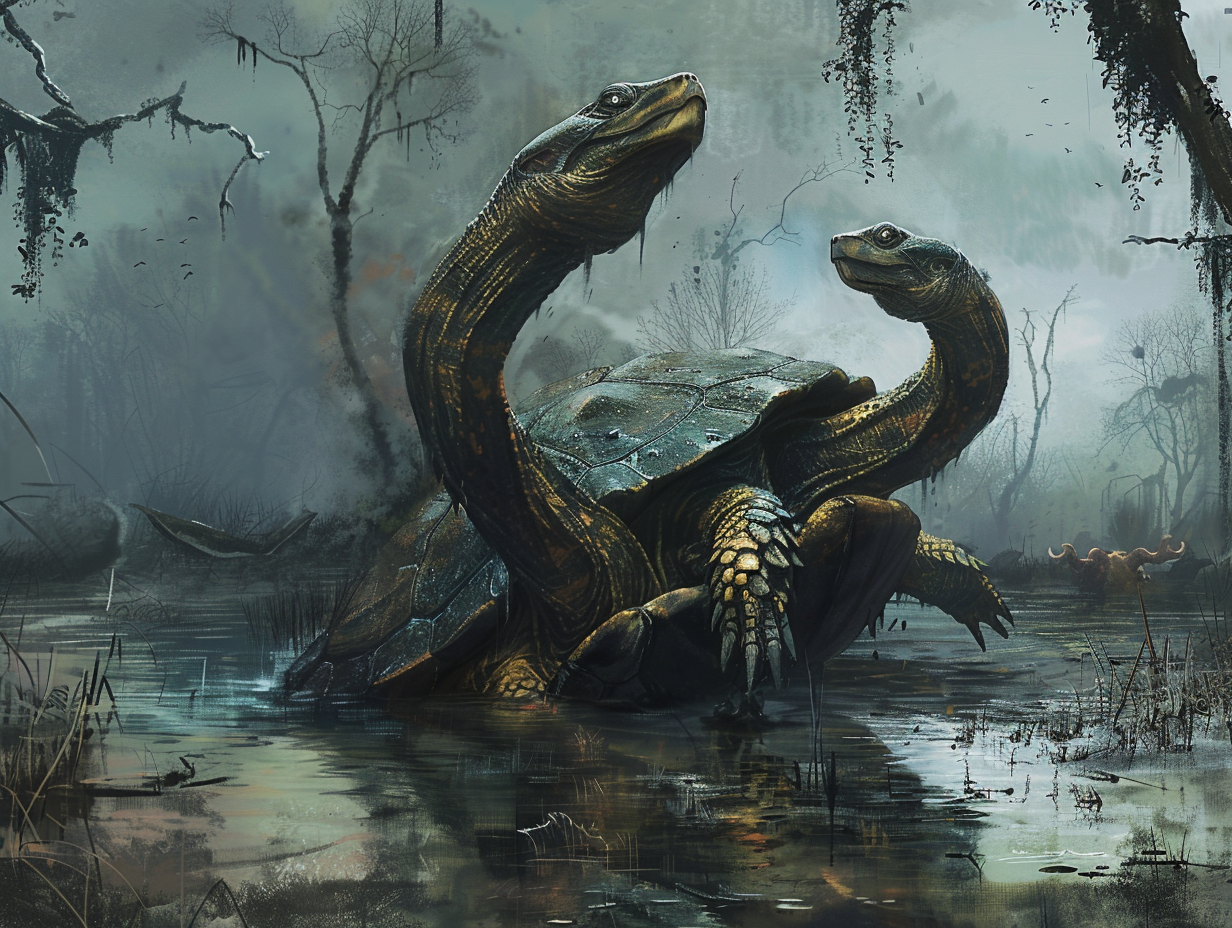Chelydra
The Chelydra was an enormous two headed snapping turtle, roughly 15 feet in length. This behemoth was found mostly in swamplands, spending most of its life submerged. Its mere presence in a lake changed the water level dramatically. They were mostly docile due to their slow metabolism, but when hunting or threatened it was something to be feared.
After about an hour of following the tracks, our hunting party arrived at a large lake in the Fleshflayer's Swamp. The dun tracker reached into his satchel and pulled out a large leg of venison--bait. I waited a second... then the water began to bubble. In a huge tidal wave, the gargantuan beast emerged from the water. The left head snaps furiously at me as the right gobbled up the deer leg. The great chelydra knew what we came for--though intruders, the duns were no strangers here. We watched the water roll off the prized shell that we travelled all this way for. We drew our weapons as the beast let out a screeching roar.

Appearance & Behaviour #
Cheldyra were black or dark gray in colour, with rough, scaly skin. Their scales were pointed, and spikes traveled down their legs and tail. They had five legs, four where you would expect them to be, and one in between their two heads. Their feet ended in sharp claws that they mostly used to shovel dirt. Their two heads had powerful jaws capable of slicing clean through their prey and humanoid enemies alike. When threatened, their long sharp tail could be swung to send foes flying backwards. Atop its back, a chelydra was protected by its hard shell. These shells were nearly impenetrable, and a chelydra was able to pull its legs and heads inside in order to protect itself from attacks. The underbelly of this turtle-like giant was also shelled, but was slightly softer. It was weakest at its sides, but it protected itself with its feet.
Growth & Reproduction #
It wouldn’t take much to kill a baby chelydra, which were about the size of a palm. Young chelydra made quick prey for predators like birds and carnivorous fish. The chelydra would lay their eggs on land, in sand or soft soil. Once they hatched, the newborns rushed to the water, where they would spend majority of their life in.
Chelydra were known to live around 300 years, and reached full size and maturity after 70. By 20 they were the size of a horse.
Habitat #
The chelydra were almost exclusively found in Fleshflayers' Swamp. They were so rare because their specific habitat requirements and excessive hunting from dun tradition has left their numbers reduced.
Chelydra were known to migrate across land in search of better food, a mate, or a place to lay eggs. Adolescent chelydra were somewhat prone to being accidentally crushed by travelers' wagons or horses if they crossed a road, but before long it was the traveler who was at risk of being crushed.
Chelydra in Fleshflayers' Swamp were one of the few creatures not hunted by the titular predators. The pocket around a chelydra's territory could be a safe place of respite from voracious fleshflayers.
Cultural Impact #
Following the Demon Wars, duns sought out these creatures for their shells, which they used as roofs for their housing. Hunting parties come from Korlock down along the Modwuk River, and into Fleshflayers' Swamp. They then slayed the animal, harvested its meat, and cleaned out the shell. Finally, they would sail back to Korlock using the overturned shell as a raft.
Upon returning home, they would erect the shell as a house, with the spine and underbelly as a built in floor and support. Any drafty openings were filled with conventional building material.